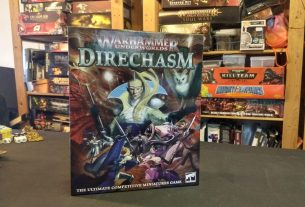
 You’ve beaten Gears of War 3 on Insane, you’ve killed thousands in Modern Warfare 3, and you’ve almost done half of what there is to do in Skyrim. But now that we’ve entered the doldrums of video game releases – what should you do with your free time? Easy – play the Gears of War: The Board Game!
You’ve beaten Gears of War 3 on Insane, you’ve killed thousands in Modern Warfare 3, and you’ve almost done half of what there is to do in Skyrim. But now that we’ve entered the doldrums of video game releases – what should you do with your free time? Easy – play the Gears of War: The Board Game!
Overview: Based on the popular video game, players take on the role of one of the COG forces and attempt to defend humanity from the invading Locust hordes in a more cardboard and plastic version of Sera’s wastelands. The game was designed by Corey Konieczka, who was also responsible for Mansions of Madness, Descent: Journeys in the Dark, and the Battlestar Galactica: The Board Game.
Players: 1 to 4
Ages: 13 & up
Playing Time: 60-180 minutes, depending on the scenario being played, number of players and familiarity with the rules.
Retail: $79.99
Rating: Two out of four curb stomps.
Who Will Like It: The obvious group is fans of the video game, but people who enjoy semi-complex war games will enjoy it too. Plus, it’s a cooperative game, which will appeal to a good number of people.
Components:
This game is from Fantasy Flight, so you know the components are going to be top-notch. In the box, you’ll find a lot:
- 32 page rulebook
- 168 bridge-sized cards, covering everything from mission details to weapon cards
- 38 mini cards for reference and locations
- 17 double-sided map tiles
- 83 tokens and markers for wounds, weapons and gameplay
- Line of sight ruler
- 5 attack and 4 defense dice
- 32 plastic figures
The quality of all of the components is excellent. The plastic figures have tons of detail and they would look great painted (especially since Marcus, Cole, and company have been cast in red plastic). The line of sight ruler is a nice inclusion and the map tiles, printed on heavy and durable cardboard stock, do a good job of capturing the destruction and decay of the game’s theme. The cards are also very nice and display a healthy dose of information on each card. However, there’s still room for all kinds of great Gears artwork, straight out of the video game.
Gameplay:
Depending on how many players and which mission card (scenario) is being used, components are collected to begin a game. Players set up the game according to the scenario, placing game tiles, monsters and arranging cards. Each player chooses a character and draws a hand of cards for that player. Characters are also assigned weapons and ammo and possibly other benefits depending on the special ability assigned to each character.
Play consists of three steps. The first step is for the character to heal up, which is done by drawing two cards into the player’s hand (but without exceeding the hand limit, which is six cards for most players). The hand cards are used to complete actions like moving and attacking, but each time a card is spent, it represents a loss of health. When a character’s hand cards are depleted, he is bleeding out and near death. He can be rescued by another player, but this is accomplished by the sharing of hand cards, which depletes the other character’s health.
The second step is the COG Order step where the player’s character moves, attacks, or a variety of other actions. The player selects a card from his hand and resolves any actions dictated by the card. Alternately, the player can ignore all actions on the card and move two areas or make one attack. Attacks are made by consulting enemy and weapon cards, checking for cover, range, and line of sight and then rolling the appropriate number of attack dice against defense dice. Attacks can be bolstered with additional attack dice by using ammo tokens to provide a more powerful/accurate attack or by rolling an “omen” pip on the attack dice, which equates to additional damage or instant death.
At the conclusion of the COG Order step, a player can accomplish a single special action. He can revive a bleeding-out teammate, pick up dropped weapons or ammo (potentially awarded after killing a monster), or activate an area’s equipment. Activating an area’s equipment typically involves discarding a card from a player’s hand cards in exchange for grenades or ammo, however, there are some variations on this, such as free activation as part of a COG Order card.
Next, the player activates the Locust by drawing a Locust AI card. The card identifies what monster is affected and what action should be taken, depending on that creature’s location and health status. The monster affected may be outside the player’s tile and, depending on the cards played, the players may soon have every monster in the scenario bearing down on them.
Play then moves on to the next player who completes the same steps. The game continues until players have accomplished all the goals on the mission card or until all players are bleeding out.
Overall, I’m on the fence about this game. There are some things I really like about it and some things I really don’t.
The quality of the components are wonderful and make you want to pick up the game and play. The difficulty and constant onslaught captures the feeling of playing Gears of War on Hardcore or Insane and the enemies can be equally tough. What’s more, thanks to the artwork on the cards and tiles, you almost feel like you’re playing the video game.
While the game can accommodate up to four players, we had the most fun with two. There are a couple of reasons for this. First, a second player can mean the difference between winning and losing a game because of the bleeding out rule. But, more importantly, because of the game’s turn structure, a player can spend a lot of time doing nothing while waiting for his next turn when playing with three or four players. Even then, play never really flows. It feels like it happens in fits and starts, unlike the frenetic pace those familiar with Gears of War have grown to expect from the game.
What’s more, the Gears of War video game is great because it makes potentially complex game maneuvers simple to perform, for example, its amazing cover system. Where the board game falls short for me is that it tries too hard to be faithful to the video game. As a result, it adds an unnecessary layer of complexity to gameplay. For example, in the rule book, a basic attack example contains eleven steps. As a result, it feels more like walking through a checklist than being in combat.
Additionally, learning the game’s rules was a bit of a challenge and casual gamers may find this game a little intimidating. On the first go around, my test group, which included a couple kids on the younger end of the age range, got fed up with trying to figure out the rules, so we ended up playing something else. On the second try, I played a one-player game to get some familiarity before bringing others back in. It still took a good chunk of time (and a healthy bit of re-reading), but I got it before I invited some other players over for a third go around.
I don’t feel like I can give this game a definitive recommendation. I think some people will love it, simply because it gives them the opportunity to play a board game in the Gears universe. Others will likely hate it because gameplay doesn’t flow very well and games go on too long. If Gears of War: The Board Game appeals to you, find a demo copy at your local game store and find out what you think. Delta out.
Disclosure: Fantasy Flight sent GeekDad a copy of this game.





